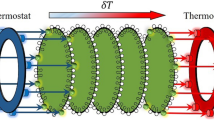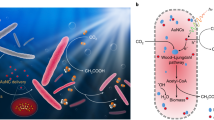Abstract
The efficiency of classical photocells is restricted by Shockley–Queisser limit and radiative recombination is one of the key contributors in efficiency degradation. Recent experiments on photosynthetic apparatus of plants and bacteria have suggested that these systems can overcome this limitation by exploiting excitonic quantum coherence. In photosynthetic apparatus, solar photons create excitons in the pigment protein molecules. These excitons are then transferred to the reaction centre where charge separation takes place. These processes – excitonic generation and subsequent charge separation – are extremely efficient with almost unity efficiency and avoid efficiency degradation due to radiative recombination. Taking a cue from this biophysical process, we propose a GaN quantum dot-based quantum photocell that emulates the photosynthetic reaction centre. The proposed photocell uses delocalised excitons to exhibit efficiency larger than its classical counterpart. This further suggests that highly efficient quantum biological processes can give important pointers for developing energy harvesting quantum technologies.








Similar content being viewed by others
References
D O Hall and K K Rao, Photosynthesis (Cambridge University Press, 1999)
H S Yoon, J D Hackett, C Ciniglia, G Pinto and D Bhattacharya, Mol. Biol. Evolut. 21(5), 809 (2004)
R E Blankenship, M T Madigan and C E Bauer, Anoxygenic photosynthetic bacteria (Springer Science & Business Media, 2006) Vol. 2
R E Blankenship, Molecular mechanisms of photosynthesis (John Wiley & Sons, 2013)
J Strümpfer, M Sener and K Schulten, J. Phys. Chem. Lett. 5(3), 536 (2012)
C Creatore, M A Parker, S Emmott and A W Chin, Phys. Rev. Lett. 111(25), 253601 (2013)
M O Scully, K R Chapin, K E Dorfman, M B Kim and A Svidzinsky, Proc. Natl Acad. Sci. 108(37), 15097 (2011)
J C Brookes, Proc. R. Soc. A: Math. Phys. Eng. Sci. 473(2201), 20160822 (2017)
N Lambert, Y N Chen, Y C Cheng, C M Li, G Y Chen and F Nori, Nat. Phys. 9(1), 10 (2013)
R J Cogdell, A Gall and J Köhler, Quart. Rev. Biophys. 39(3), 227 (2006)
J Deisenhofer, O Epp, K Miki, R Huber and H Michel, Nature 318(6047), 618 (1985)
E Romero, I HM van Stokkum, V I Novoderezhkin, J P Dekker and R van Grondelle, Biochemistry 49(20), 4300 (2010)
K E Dorfman, D V Voronine, S Mukamel and M O Scully, Proc. Natl Acad. Sci. 110(8), 2746 (2013)
G Yu and A J Heeger, J. Appl. Phys. 78(7), 4510 (1995).
E Biolatti, R C Iotti, P Zanardi and F Rossi, Phys. Rev. Lett. 85(26), 5647 (2000)
S De Rinaldis, I D’Amico, E Biolatti, R Rinaldi, R Cingolani and F Rossi, Phys. Rev. B 65(8), 081309 (2002)
D Loss and D P DiVincenzo, Phys. Rev. A 57(1), 120 (1998)
J R Petta, A C Johnson, J M Taylor, E A Laird, A Yacoby, M D Lukin, C M Marcus, M P Hanson and A C Gossard, Science 309(5744), 2180 (2005)
A J Nozik, Physica E 14(1), 115 (2002)
V Aroutiounian, S Petrosyan, A Khachatryan and K Touryan, J. Appl. Phys. 89(4), 2268 (2001)
L D Contreras-Pulido, M Bruderer, S F Huelga and M B Plenio, New J. Phys. 16(11), 113061 (2014)
Acknowledgements
The author would like to thank Prof. Swaroop Ganguly, IIT Bombay for insightful comments about this work. This work is supported by the Department of Science and Technology (DST), India with Grant No. DST/INSPIRE/04/2018/000023.
Author information
Authors and Affiliations
Corresponding author
Rights and permissions
About this article
Cite this article
Poonia, V.S. A novel bioinspired quantum photocell based on GaN quantum dots. Pramana - J Phys 96, 102 (2022). https://doi.org/10.1007/s12043-022-02349-4
Received:
Revised:
Accepted:
Published:
DOI: https://doi.org/10.1007/s12043-022-02349-4
Keywords
- Quantum physics
- biophysics
- quantum technology
- nanotechnology
- photosynthetic reaction centre
- quantum biology
- coherence
- quantum dots
- quantum biomimetics
- solar light harvesting




